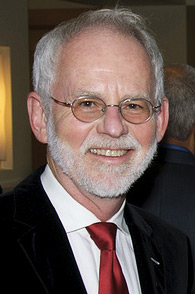Roy Pea
Roy Pea | |
|---|---|
 Pea at TeachAids 2010 inaugural gala | |
| Born | Roy D. Pea July 5, 1952 (age 71) |
| Alma mater | Michigan State University University of Oxford |
| Scientific career | |
| Fields | Learning sciences Educational technology Collaborative learning STEM learning[1] |
| Thesis | The development of negation in early child language (1978) |
| Doctoral advisor | Jerome Bruner |
| Doctoral students | Shuchi Grover[2] |
| Website | profiles |
Roy D. Pea is David Jacks Professor of Learning Sciences and Education at the
Education
Pea was born in
Career and research
After studying child language and cognitive development from 1975 to 1980, his research concerns were attracted to understanding how innovations in computing and communications technologies can significantly influence learning, thinking, collaboration, and educational systems. Pea is a key figure in the development of the
Pea was one of the first research scientists to build the
Research centers and industry advisor
In 1996, after a year at the Center for Advanced Studies in the Behavioral Sciences, Pea was recruited to SRI International, where he worked with colleagues to build a major national Center for Technology in Learning,[8] until recruited to Stanford University in 2001. At Stanford, Pea co-founded Stanford's H-STAR Institute (Human Sciences and Technologies Advanced Research) with Byron Reeves and is now H-STAR Institute Director.[9] He was also co-director of the National Science Foundation-funded LIFE Center,[10] one of six national Science of Learning Centers, whose studies seek to inform better bridging of the sciences of informal and formal learning from 2004 to 2017.
In addition to serving as founding editor of the Cambridge University Press Series Learning in Doing: Cognitive, Social and Computational Perspectives since 1987,[11] Pea was co-author of the 2000 National Academy Press volume How People Learn,[12] Co-Editor of the 2007 Book Video Research in the Learning Sciences,[13] and co-author of the 2010 US National Educational Technology Plan.[14]
Pea served from 1999 to 2009 as a founding director for Teachscape,[15] a company he co-founded with Mark Atkinson in 1999 that provides comprehensive K-12 teacher professional development services incorporating web-based video case studies of standards-based teaching and communities of learners. In addition to academic research and teaching, he advises a number of companies, non-profits, research centers, projects and federal agencies or foundations involved in learning with technologies. Pea is also a learning sciences advisor to HIV/AIDS education nonprofit TeachAids.[16]
He is a Fellow of the
References
- ^ a b Roy Pea publications indexed by Google Scholar
- ^ OCLC 887992596.
- EThOS uk.bl.ethos.468493.
- ^ "Cross-Area Specialization - Learning Sciences and Technology Design". Stanford Graduate School of Education.
- ISBN 9780521574235. Retrieved 2022-05-31.
- ^ Pea, Roy (1991). "Learning Through Multimedia". IEEE Computer Graphics and Applications.
- ^ "Dynagrams". Stanford.edu. Retrieved 2022-05-31.
- ^ "Center for Technology in Learning". SRI International. Retrieved 2013-06-14.
- ^ H-STAR Institute
- ^ LIFE Center
- ^ "Learning in Doing: Social, Cognitive and Computational Perspectives". Cambridge University Press.
- ISBN 978-0-309-07036-2. Retrieved 2022-05-31.
- ISBN 978-0805853605.
- ^ "National Education Technology Plan 2010 | U.S. Department of Education". Archived from the original on 2011-05-20. Retrieved 2011-05-24.
- ^ "Teachscape K12". Teachscape. Archived from the original on 2011-07-11. Retrieved 2022-05-31.
- ^ "TeachAIDS: Team". TeachAids. 16 December 2010. Archived from the original on 10 June 2010. Retrieved 16 December 2010.
- ^ "ISLS Fellows". International Society of the Learning Sciences.
